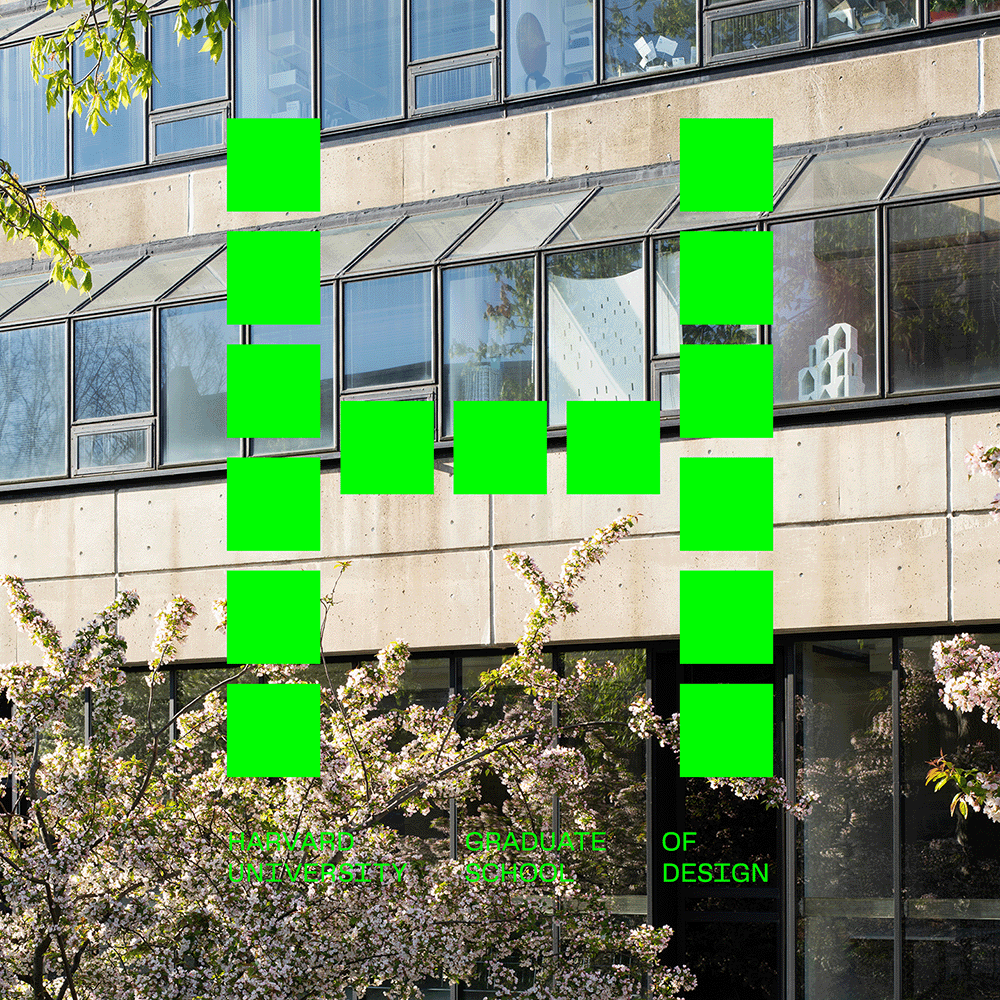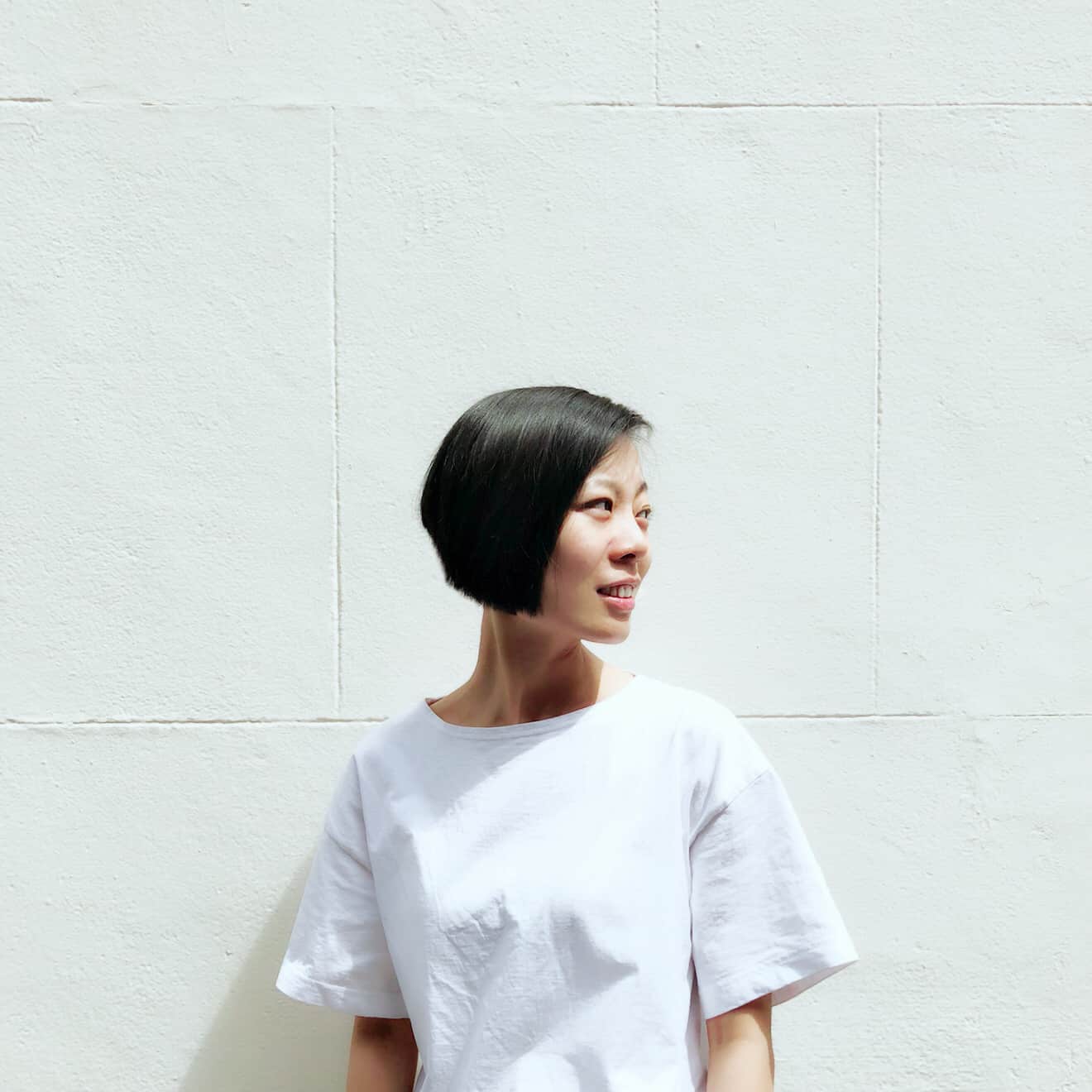Curry J. Hackett and Gabriel Jean-Paul Soomar Win the Radcliffe Institute Public Art Competition
Harvard Radcliffe Institute recently announced Curry J. Hackett (MAUD ’24) and Gabriel Jean-Paul Soomar (MArch II/MDes ’24) winners of the biennial Radcliffe Institute Public Art Competition . The duo won for their innovative proposal titled HOLD, a 30-foot-long U-shaped enclosure designed to symbolize the spaces Black communities construct for themselves, nodding to the screened porches of the American South while acknowledging the cargo holds of slave ships. The artwork is expected to be unveiled at the Susan S. and Kenneth L. Wallach Garden on Brattle Street in May 2024.
The competition offers Harvard students an opportunity to showcase projects at the intersection of art, landscape design, and structural architecture. Participants compete for a prize that includes funding for the construction of the artwork and mentorship throughout the development and installation process.
HOLD is designed to be “an outdoor experience that acknowledges and celebrates the complicated relationship Black folks maintain with enclosure,” the artists said in a statement . The structure will serve as a reminder of the various ways in which Black mobility has been restricted (redlining, incarceration, slavery) while also calling to mind the spaces Black communities build for themselves (the Black church, the front porch, the hair salon)—spaces which signify safety and embrace. Hackett and Soomar intend for HOLD to be a gathering place for events and classes—a place “for Black students and underrepresented students across campus to find space and create space for themselves.”
This public art installation is the first for Soomar and the fourth for Hackett, although Soomar has seen his work exhibited at such notable institutions as New York’s Museum of Modern Art (MoMA) and the Venice Biennale Architettura 2023. Hackett was also a shortlist candidate for the 2022 Wheelwright Prize.
The Radcliffe Institute for Advanced Study at Harvard University—also known as Harvard Radcliffe Institute—is one of the world’s leading centers for interdisciplinary exploration. We bring students, scholars, artists, and practitioners together to pursue curiosity-driven research, expand human understanding, and grapple with questions that demand insight from across disciplines. For more information, visit www.radcliffe.harvard.edu .
Adam Longenbach Receives 2023 Carter Manny Award Citation of Special Recognition
Adam Longenbach, a doctoral candidate in Architecture, Landscape Architecture, and Urban Planning, was recently honored with a Carter Manny Award citation of special recognition from the Graham Foundation . He is also a 2023–2024 Graduate Fellow in Ethics at the Edmond and Lily Safra Center for Ethics and a 2023 Harvard Horizons Scholar.
Established in 1996, the Carter Manny Award program supports the completion of outstanding doctoral dissertations on architecture and its role in the arts, culture, and society. The only pre-doctoral award dedicated exclusively to architectural scholarship, it recognizes emerging scholars whose work promises to challenge and reshape contemporary discourse and impact the field at large.
In his dissertation “Stagecraft / Warcraft: The Rise of the Military Mock Village in the American West, 1942–1953,” Longenbach investigates the mid-twentieth-century entanglement of wartime policies, government agencies, private sector collaborations, and mass media technologies that led to the rise of military “mock villages.” His work connects this history to the ongoing production and operation of mock villages by militaries and police forces around the world, questioning what it means to replicate the built environment for the purpose of enacting violence in and against it.
Before coming to Harvard, Longenbach practiced for nearly a decade in several design offices, including Olson Kundig Architects, Allied Works Architecture, and Snøhetta, where he was the director of post-occupancy research. His writing can be found in Thresholds, The Avery Review, and Log, among others.
Martin Bechthold, Holly Samuelson, and Amy Whitesides Receive Project Funding from the Salata Institute Seed Grant Program
The GSD’s Martin Bechthold, Holly Samuelson, and Amy Whitesides are among the grant recipients of the first Salata Institute Seed Grant Program, launched in April to enable new interdisciplinary research in climate and sustainability. The program will support 19 faculty members working across seven Harvard Schools with funding for projects ranging from exploring a new, algae-based building insulation material to researching the carbon footprint of AI-driven computing.
Martin Bechthold, Kumagai Professor of Architectural Technology and Co-Director of the Doctor in Design Studies Program, is co-principal investigator on a project with Jennifer Lewis of the John A. Paulson School of Engineering and Applied Sciences. The team will research and develop a proof of concept for a carbon-negative insulation material made from microalgae, a cost-effective way to reduce buildings’ energy consumption and emissions.
Holly Samuelson, Associate Professor of Architecture, is the principal investigator on a project researching how architects can prioritize saving heating or cooling energy by analyzing the potential benefits of revising glass requirements. The optimal glass properties depend on not only building type and window orientation—variables already lumped together in today’s broad-brush building codes—but also properties of evolving heating systems and electricity generation.
Amy Whitesides, Design Critic in Landscape Architecture, is the principal investigator studying how forests play a crucial role in mitigating climate change. Agroforestry may offer means to diversify and protect lands that face encroachment and climate threats and often support lower-income communities. In support of the project, Whitesides will bring together landscape architects, planners, foresters, farmers, municipalities, and land management specialists.
Announcing the Harvard GSD Fall 2023 Public Program
The Harvard Graduate School of Design (GSD) announces its Fall 2023 schedule of public programs and exhibitions. Many of the season’s initiatives reflect on the relationship between design and the public good. Pritzker Architecture Prize recipient Shigeru Ban will present a lecture on balancing architectural practice and social engagement (September 19). Angela D. Brooks, housing justice advocate and president of the American Planning Association, will deliver the Rachel Dorothy Tanur Memorial Lecture (November 1). Featuring keynote speakers Germane Barnes, Renata Cherlise, Nina Cooke John, and Bryan Mason, the fifth biannual Black in Design conference (September 22–24), explores the multidimensionality of “The Black Home.” Rethinking the space of law and punishment is the focus of the Carceral Landscapes symposium (October 12–13), co-organized by the GSD and the Institute to End Mass Incarceration at Harvard Law School.
The program launches on September 12 with a release event for Harvard Design Magazine #51: “Multihyphenate,” featuring guest editors Sean Canty, Assistant Professor of Architecture, and John May, Associate Professor of Architecture, both from the GSD, and Zeina Koreitem, design faculty at the Southern California Institute of Architecture (SCI-Arc). The associated exhibition Multihyphenation will be on display at the Druker Design Gallery August 30 through October 9, 2023.
The climate emergency provides an urgent touchstone for other programs, including the exhibition Our Artificial Nature: Perspectives on Design for an Era of Environmental Change (opening October 26). The presentation will spotlight research conducted at the Harvard Center for Green Buildings and Cities . In tandem with the exhibition, the GSD will host Carson Chan, curator at the Museum of Modern Art in New York, who will engage GSD faculty in a conversation about past design speculations, current research, and practice. Kongjian Yu, Professor and Dean, College of Architecture and Landscape Architecture, Peking University, will lecture on ecological urbanism (September 14), and Tomás Folch, Design Critic in Landscape Architecture at the GSD, will discuss water in Andean cities (November 3).
The complete public program calendar appears below and can be viewed on Harvard GSD’s events calendar. Please visit Harvard GSD’s home page to sign up to receive periodic emails about the School’s public programs, exhibitions, and other news.
Fall 2023 Public Program
Multihyphenation
Exhibition associated with Harvard Design Magazine #51: “Multihyphenate”
Druker Design Gallery
August 30–October 9
Harvard Design Magazine #51: “Multihyphenate,” issue launch with editors Sean Canty, Zeina Koreitem, and John May
Frances Loeb Library
September 12, 12:30pm
Kongjian Yu
Sylvester Baxter Lecture
September 14, 6:30pm
Shigeru Ban, “Balancing Architectural Works and Public Contributions”
September 19, 6:30pm
Black in Design 2023: The Black Home
September 22–24
Tickets available through the conference website
Irma Boom and Remment Koolhaas, “Bookmaking”
September 27, 6:30pm
Michele De Lucchi, “Earth Stations: Future Sharing Architecture”
September 28, 6:30pm
Anita Berrizbeitia, “The Blue Hills: Charles Eliot’s Design Experiment (1893–1897)”
Frederick Law Olmsted Lecture
October 10, 6:30pm
Carceral Landscapes
Symposium
October 12–13
This event is co-organized by the GSD and the Institute to End Mass Incarceration at Harvard Law School
David Gissen in conversation with Sara Hendren
Loeb Lecture
October 17, 6:30pm
Manuel Salgado, “City Making”
Jaqueline Tyrwhitt Urban Design Lecture
October 24, 6:30pm
Our Artificial Nature: Perspectives on Design for an Era of Environmental Change
Exhibition
Druker Design Gallery
October 26–December 21
Angela D. Brooks
Rachel Dorothy Tanur Memorial Lecture
November 1, 6:30pm
Tomás Folch, “Hydraulic Geographies: Atlas of the Urban Water in the Andean Region”
Kiley Fellow Lecture, Room 112 Stubbins
November 3, 12:30pm
Lina Ghotmeh, “Living in Symbiosis–an Archeology of the Future”
November 6, 6:30pm
Pier Vittorio Aureli, “The Longhouse”
November 9, 6:30pm
Catherine Mosbach, “Design is a Language being Receptive being in Motion”
Aga Khan Program Lecture
November 14, 6:30pm
Opening of Our Artificial Nature: Perspectives on Design for an Era of Environmental Change
Thursday, November 16, 6:30pm
Conversation co-organized by the GSD and the Harvard Center for Green Buildings and Cities and moderated by Carson Chan, Director, Emilio Ambasz Institute for the Joint Study of the Built and Natural Environment, MoMA
All programs take place in Piper Auditorium, are open to the public, and will be simultaneously streamed to the GSD’s website, unless otherwise noted.
Registration is not required, unless otherwise noted. Please see individual event pages for full details and the most up-to-date information.
The Design Thinking Behind the GSD’s New Identity
A Language and a Tool
A visual identity is both a language and a tool. The Harvard Graduate School of Design needed an updated language of forms to communicate the School’s mission and values, as well as a tool to facilitate its pedagogical activities and day-to-day operations with a common set of visual standards.

Dean Sarah M. Whiting, in welcoming the GSD community back last year as Covid-19 pandemic restrictions eased, described the School as a place that synthesizes different and sometimes competing frameworks of knowledge. She challenged GSD students, faculty, staff, and affiliates to drive a public dialogue, bringing the knowledge produced at the School to the world.
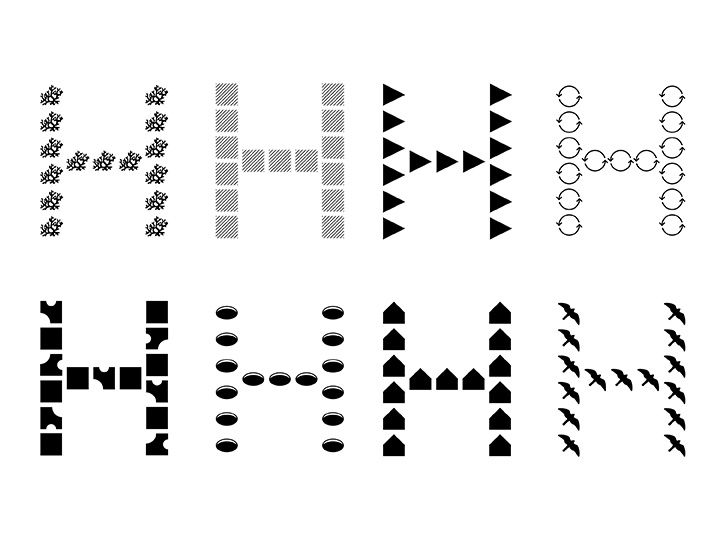
Conceived this way, the GSD is a dynamic center for learning and discourse. An identity that can help galvanize the breadth of the GSD community and convey the diversity of its ideas must be both adaptable and resilient. It needs to be functional, able to work with everything from large-scale physical signage to social media posts. In every context, the identity has to embody the critical design thinking at the heart of the School.
The University
The GSD is rooted in the broader Harvard University community. Early versions of the School’s identity took the Harvard shield as a point of departure. Right at the turn of the 21st century, the GSD departed from this tradition—and set itself apart from other Harvard schools—by adopting the “Flying H”, designed by Nigel Smith.

The abstracted Harvard “H” projects the dynamic outlook of an educational institution devoted to fostering leaders in design, research, and scholarship.
The School
The heart of the GSD is our main building, Gund Hall. This is where the energy associated with learning, teaching, and study is most palpable. In turn, the Trays are at the heart of Gund. This iconic space facilitates the work that happens here.
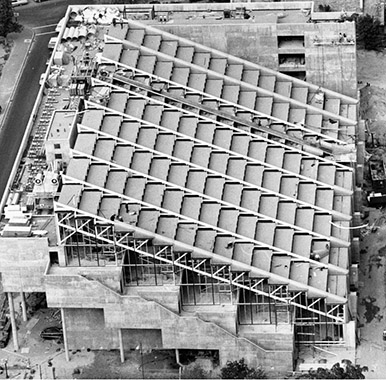
John Andrews, the architect of Gund Hall, affirmed this importance through his design—the Trays were not part of his brief for the building’s design and are solely his invention. The Trays serve as the backbone of the building. They also define its distinctive form. The physical structure of the building is also the symbolic foundation of the School. In a sense, Gund Hall is a language and a tool: a visual identity expressed in the built environment.
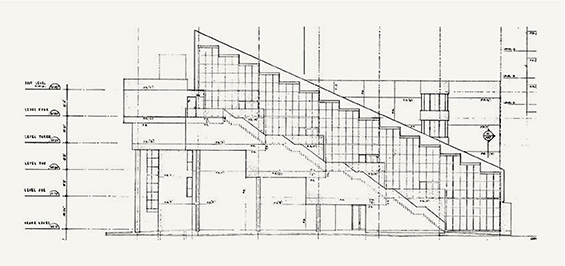
The Structural H
We took inspiration from Gund to develop the new GSD logo. The letter “H” immediately connects the GSD with Harvard. If we strip away the surface of the glyph, we reveal the underlying structure of the letter’s form and composition: its architecture. The letterform foregrounds the features of its own design and construction, just as Gund Hall does. The visual form, derived from self-reflexive inquiry, both embodies and represents the GSD’s pedagogical mission.
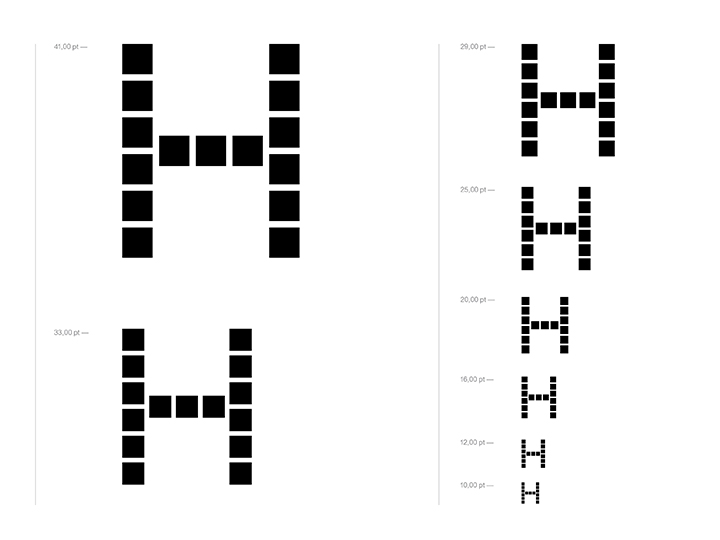
A Multiplicity of H’s
An institutional identity grows and changes over time. The GSD encompasses the multifaceted work that happens at Gund Hall. But the institution is bigger than a building. It is the network of people who put in the work—organizing, teaching, studying, building, communicating, and ultimately fashioning the School in their own unique ways. To be true to the GSD, the structure of the logo needs to accommodate a myriad of creative perspectives. A template of the “H” structure is available to students, faculty, and staff who are empowered to create their own versions of the wordmark.
Typeface
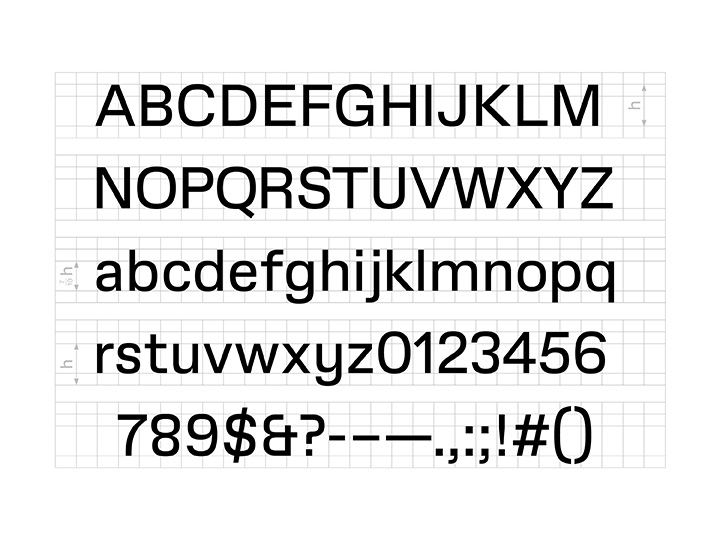
GSD Gothic is both an aesthetic companion to our new logo and a unique means of addressing a wide audience. It needs to be legible in different environments, from signage that feels at home in Gund Hall to dense documents circulating in print or online. It is the workhorse of the identity.
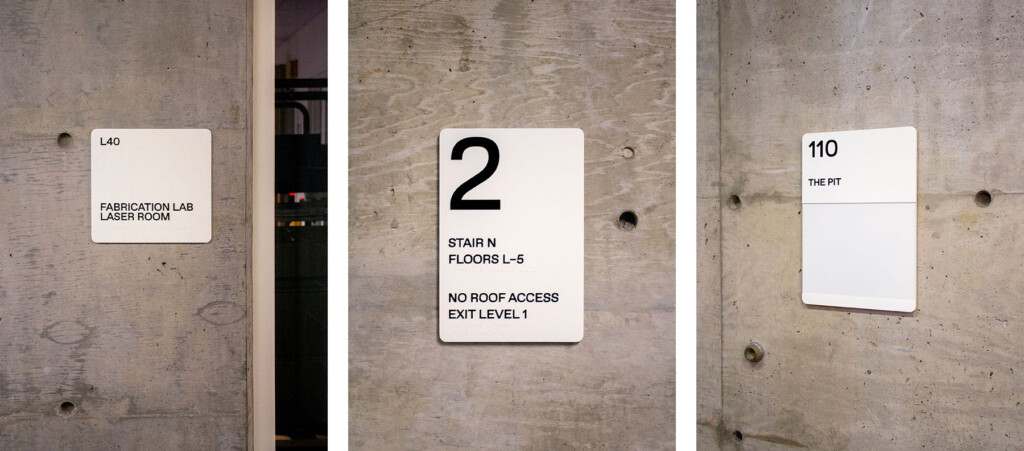
Variable Font for the Digital World
The typeface will exist in two different formats. A traditional format has different weights and styles—that is, regular, italic, bold. GSD Gothic will also exist in a variable format, an approach to typography suited to the digital world.
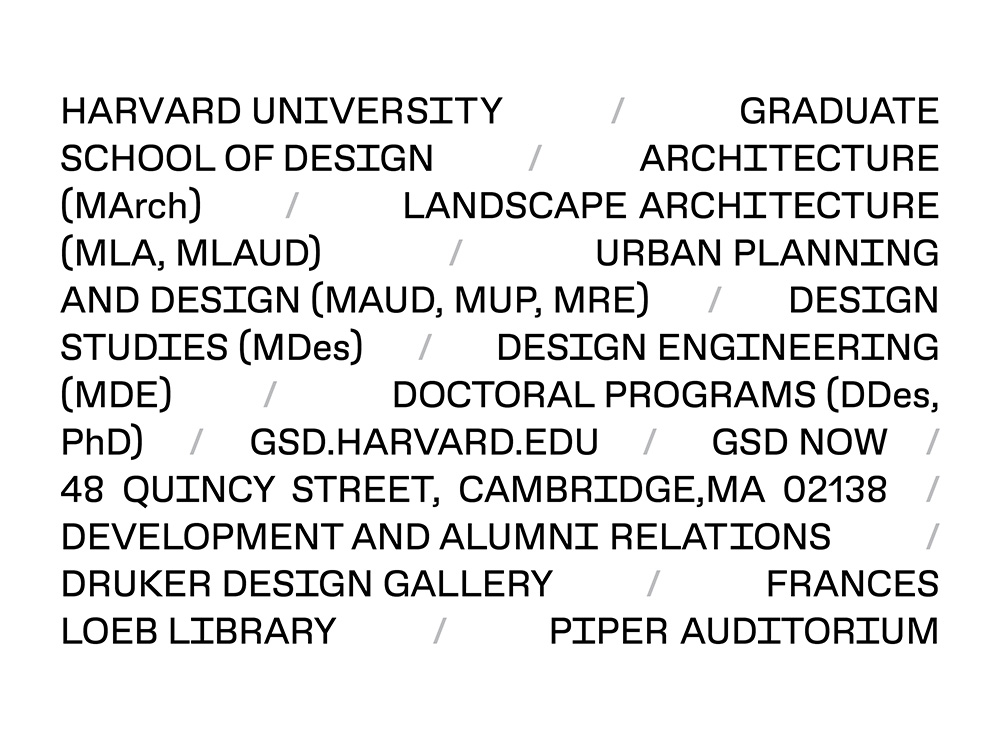
A variable format does not have discrete styles; it can exist in any variable between a set of parameters. This version of the typeface is delivered not in files but in code. It can live on our website and within other digital assets, and it can be programmed to react to dynamic conditions of display.
A System
The logo and wordmark function as separate elements, each addressing different needs.
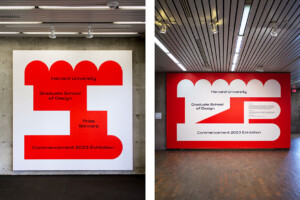
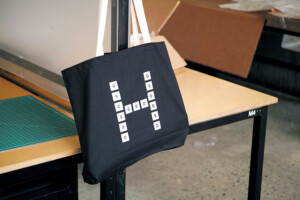
But sometimes they come together. The different elements of this system will be displayed throughout the GSD, online, and in the documents that GSD community members use to correspond with the world.

The Harvard Graduate School of Design embarked on its new visual identity in 2022. It was officially adopted in fall of 2022, and since then has been implemented in phases. The GSD’s art director, Chad Kloepfer, designed the new identity.
Welcoming 2023–2024 Pollman Fellow Tosin Fateye

The Harvard Graduate School of Design (GSD) is pleased to welcome Tosin B. Fateye as the Pollman Fellow in Real Estate and Urban Development for the 2023–2024 academic year.
Fateye is a lecturer at the Redeemer’s University, Ede, Osun State, Nigeria. Having completed his Doctor of Philosophy (PhD) in Estate Management (Real Estate Investment and Finance option) at the Obafemi Awolowo University, Ile-Ife, Osun State, Nigeria, he holds BSc and MSc degrees in Estate Management at the same University. He teaches and carries out research in the areas of real estate investment appraisal, property development and finance, and sustainable real estate. Fateye is an International Real Estate Business School (IREBS) Foundation Scholar, a corporate member of the Nigerian Institution of Estate Surveyors and Valuers (ANIVS), a member of the African Real Estate Society (AfRES), and a Registered Estate Surveyor and Valuer (RSV). Fateye’s writings have been published in real estate trade journals, and two of his conference papers have won IREBS/AfRES Best Paper Award in the Real Estate Investment and Finance, and Valuation categories in 2018 and 2021 respectively.
Fateye’s research focuses on real estate investment performance measurement using econometric models. While his previous works focused on assessing property investment performance using underlying market fundamental and technical analyses, he is interested in exploring the behavioral finance approach to evaluate real estate pricing dynamics for comprehensive and optimal investment decision-making.
One of the fellowships and prizes administered by the GSD’s Department of Urban Planning and Design, the Pollman Fellowship was established in 2002 through a gift from Harold A. Pollman. It is awarded annually to an outstanding postdoctoral graduate in real estate, urban planning, and development who spends one year in residence at the GSD as a visiting scholar.
The Black in Design Conference 2023 Receives Graham Foundation Grant
The Black Home , Black in Design Conference 2023, organized by Dora Mugerwa, Michael “MJ” Johnson, Kai Walcott, Tobi Fagbule, and Sean Canty, has been awarded a grant from the Graham Foundation for Advanced Studies in the Fine Arts . The Black in Design conference recognizes the contributions of the African diaspora to the design fields and promotes discourse around the agency of the design professions to address and dismantle the institutional barriers faced by Black communities.
The fifth biannual conference takes place September 22–24, 2023. This edition explores the multidimensionality of the Black home, which the organizers characterize as “a literal structure that shelters, as a reflection of culture and traditions, and as spaces that are not entirely physical.” Through keynote panels, workshops, and conversations, conference participants will develop a broader understanding of the Black home as part of “an effort to reinforce the ideals of Black communities living across the country and larger diaspora so that we can plan for its future.”
Founded in 1956, the Graham Foundation for Advanced Studies in the Fine Arts makes project-based grants to individuals and organizations and produces public programs to foster the development and exchange of diverse and challenging ideas about architecture and its role in the arts, culture, and society.
Jingru (Cyan) Cheng Wins Harvard GSD’s 2023 Wheelwright Prize
Fellowship to support Cheng’s research proposal, an examination of the critical role of sand in human communities and the built environment.
Harvard University Graduate School of Design (GSD) is pleased to name Jingru (Cyan) Cheng the winner of the 2023 Wheelwright Prize , a $100,000 grant to support investigative approaches to contemporary architecture, with an emphasis on globally minded research. Her project, Tracing Sand: Phantom Territories, Bodies Adrift, focuses on the economic, cultural, and ecological impacts of sand mining and land reclamation. From airports to beaches and river basins to hydroelectric dams, sand is a humble material that has a fundamental role in the built environment and human communities. Supporting modern cities and modern life, sand is a key component of concrete, glass, asphalt roads, and artificial land. However, by dredging underwater systems and channels, sand mining erodes riverbanks and disrupts ecosystems. Colossal amounts of sand are mined and moved to shape one habitat while destroying another.
The Wheelwright Prize will fund two years of Cheng’s research and travel, including visits to airports in Singapore, beaches in Florida, rivers in the Mekong Delta in Vietnam, and rural immigrant communities in China. Investigating how sand is mined and used in these diverse sites, Cheng will conduct interviews with key stakeholders and research design decisions, procurement routes, contractual relations, financing, regulations, and policies. She also plans to develop educational and public programs, and a multi-media archive that will be open access and made available for the affected communities, activist groups, and associated researchers.
“The proposal of Tracing Sand is the convergence of my different lines of work so far, the teachings that made me an architect, and the life experiences that made me. I see architectural materiality as an active, tangible force driving and shaping long chains of consequences and dependencies. It draws surprising connections between sites, communities, and ecologies. Winning the Wheelwright Prize affirms that the questions I’m after are part of the larger quest of architecture today, at a time of intensified social injustice and ecological crisis,” Cheng says. “As a travel-based design research award, the Wheelwright cannot be more fitting for this rather audacious proposition: to follow sand is to trace architectural materiality through supply chains and ecosystems. It is to learn through embodied experiences the entangled flows of people, life forms, matter, and the built environment across scales. Understanding how interconnected and interdependent we all are is fundamental today. I believe architecture provides a material wayfinding through this almost incomprehensible entanglement—and offers possibilities to transform it.”
“In his book The World in a Grain (2018), American-Canadian journalist Vince Beiser underscores why sand affects each and every one of us: ‘It is to cities what flour is to bread, what cells are to our bodies: the invisible but fundamental ingredient that makes up the bulk of the built environment in which most of us live.’ Cyan Cheng’s Wheelwright proposal takes Beiser’s claim one step further: sand underpins our built environment, but also our global economy,” says Sarah M. Whiting, Harvard GSD’s Dean and Josep Lluís Sert Professor of Architecture. “Tracing together material evidence, technological expertise, labor practices, and corporate reach, Cheng’s study has breadth that makes it relevant to every community across the globe, and specificity that promises to reveal hitherto unknown repercussions of this fragile resource.”
Jurors for the 2023 prize include: Noura Al Sayeh, Head of Architectural Affairs for the Bahrain Authority for Culture and Antiquities; Mira Henry, design faculty at Southern California Institute for Architecture; Mark Lee, Professor in Practice of Architecture at Harvard GSD; Jacob Reidel, Assistant Professor in Practice of Architecture at Harvard GSD; Enrique Walker, Design Critic in Architecture at Harvard GSD; and Sarah M. Whiting, Dean and Josep Lluís Sert Professor of Architecture at Harvard GSD.
“Tracing Sand examines an increasingly ubiquitous material that is at the base of the production of land and architecture by following its sourcing and consumption, unveiling the increasing entanglement of matter and site, as well as the livelihoods affected by its extraction,” observes Noura Al Sayeh, Head of Architectural Affairs for the Bahrain Authority for Culture and Antiquities. “By dissecting the complexity of material supply chains and the complicity of architecture in the destruction of natural environments, Cyan’s research bridges opposing sites and actors, from extraction to consumption, local communities to stakeholders. Through a multi-media approach and an in-depth analysis of the guts of hypermodernity, the proposal aims towards a comprehensive shift in the value system of architecture.”
The Wheelwright Prize supports innovative design research, crossing both cultural and architectural boundaries. Winning research proposal topics in recent years have included the potential of seaweed, shellfish, and the intertidal zone to advance architectural knowledge and material futures; how spaces have been transformed through the material contributions of the African Diaspora; and new architecture paradigms for storing data that can reimagine digital infrastructure.
Cheng was among four distinguished finalists selected from a highly competitive and international pool of applicants. The 2023 Wheelwright Prize jury commends finalists Isabel Abascal, Maya Bird-Murphy, and DK Osseo-Asare for their promising research proposals and presentations. Jingru (Cyan) Cheng follows 2022 Wheelwright Prize winner Marina Otero, whose Wheelwright project, Future Storage: Architectures to Host the Metaverse, is currently in its travel-research phase.
About Jingru (Cyan) Cheng:
Jingru (Cyan) Cheng works across architecture, anthropology, and filmmaking. Her practice follows drifting bodies—from rural migrant workers to forms of water—to draw out latent relations across scales, confronting intensified social injustice and ecological crisis. Cheng received commendations from the Royal Institute of British Architects (RIBA) President’s Awards for Research in 2018 and 2020. She is also a 2022 Graham Foundation Grantee. Her work has been exhibited internationally as part of Critical Zones: Observatories for Earthly Politics at ZKM Karlsruhe, Germany (2020–2022), the Seoul Biennale of Architecture and Urbanism (2019), the Venice Architecture Biennale (2018), among others, and is included in the Architectural Association’s permanent collection. Cheng holds a PhD by Design and MPhil in Architecture and Urban Design (Projective Cities) from the Architectural Association (AA), and was the co-director of AA Wuhan Visiting School (2015–2017). She co-led the MA architectural design studio Politics of the Atmosphere (2019–2022) and currently teaches an interdisciplinary module across all schools at the Royal College of Art in London.
About the 2023 Wheelwright Prize Finalists:
Isabel Abascal: Mother Architecture: Shaping Birth
Isabel Abascal is a Mexico City–based architect and writer. In 2015, she founded the architecture studio LANZA Atelier, along with Alessandro Arienzo. From 2015 to 2017, Abascal was the Executive Director of LIGA, Espacio para Arquitectura, a platform dedicated to the dissemination and discussion of Latin American architecture. There, she curated myriad exhibitions, and co-edited the book Exposed Architecture, published by Park Books. She has also contributed to publications such as DOMUS, Avery Review, Arquine, Wallpaper*, and the UNAM Journal, among others. Abascal studied architecture at the Universidad Politécnica de Madrid, the Technische Universität in Berlin, and at the Vastu Shilpa Foundation in Ahmedabad, under Balkrishna Doshi.
Maya Bird-Murphy: Examining Architectural Practice Through Alternative Methodology and Pedagogy
Maya Bird-Murphy is a designer, educator, and the founder of Mobile Makers, an award-winning non-profit organization bringing design and skill-building workshops to underrepresented communities. She was selected by Theaster Gates and the Prada Group as an Experimental Design Lab awardee, featured as one of 50 people who shape Chicago in Newcity Magazine, and received the 2022 Pierre Keller Prize at the Hublot Design Prize ceremony in London. In 2018, she was named as an AIGA Design + Diversity Conference National Fellow. The same year, she was featured in The American Institute of Architects’ (AIA) Emerging Professionals Exhibition 2018 for Mobile Makers. Bird-Murphy attended Ball State University and received an MArch from Boston Architectural College.
DK Osseo-Asare: Bucky in Africa: Remembering the Chemistry of Architecture
DK Osseo-Asare is a Ghanaian American designer who makes buildings, landscapes, communities, objects, and digital tools. He is a co-founding principal of the transatlantic architecture and integrated design studio Low Design Office (LowDo), based in Austin, United States, and Tema, Ghana. He holds an appointment in Humanitarian Materials at the Pennsylvania State University, where he directs the Humanitarian Materials Lab, a transdisciplinary research lab architecting materials for human welfare. He is a TED Global Fellow; member, Ghana Institution of Engineering (GhIE); and received AB in Engineering Design and MArch degrees from Harvard University, with a focus on kinetic architecture and network power.
Additional Leadership Transitions for the 2023-2024 Academic Year
Harvard University Graduate School of Design (GSD) announces additional leadership changes across academic programs that will go into to effect as of July 1, 2023.
Karen Janosky will serve as the Program Director of the Master in Landscape Architecture (MLA) degree programs, and
Charles Waldheim will once again serve as MLA Thesis Director.
Ed Eigen will serve as Narratives Domain Head for the Master in Design Studies degree program, joining Toni Griffin (Publics), Chris Reed (Ecologies), and Allen Sayegh (Mediums).
Announcing GSD Faculty Appointments and Promotions for the 2023-2024 Academic Year
The Harvard University Graduate School of Design is pleased to announce the following faculty appointments and promotions effective July 1, 2023:
Dana McKinney White (MArch/MUP ’17) appointed Assistant Professor of Urban Design
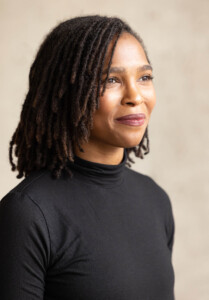
Dana McKinney White, founder of Studio KINN, and a co-founder of the enFOLD Collective, is a licensed architect and urban planner, and an outspoken advocate for social justice and equity through design. Her academic and professional work integrates wellness, policy, and economics into innovative design solutions to benefit the most vulnerable populations, including system-impacted communities, persons experiencing homelessness, and aging populations. McKinney White earned masters degrees in architecture and urban planning from the GSD, both with distinction, as well as an AB in Architecture from Princeton University. During McKinney White’s time as a student at the GSD, she helped to establish the inaugural Black in Design Conference, Map the Gap, and the African American Design Nexus. Prior to joining the GSD, McKinney White worked at Gehry Partners where she focused on the LA River Master Plan, Southeast Los Angeles Cultural Center, the Rio Hondo Confluence Area Project, and other river-related projects. During her time at Gehry Partners, Dana assisted in Frank Gehry’s Yale School of Architecture studio, “The Future of Prison,” and served as an advocate and researcher in Impact Justice’s review of the Finnish and Norwegian criminal justice systems. McKinney White subsequently served as a development manager at Adre, a purpose-driven real estate development company located in Portland, Oregon, that strives to uplift the region’s Black, Indigenous, and people of color (BIPOC) through spatial equity. She also served as a lecturer at the University of Maryland School of Architecture in their undergraduate architecture degree program and most recently as a Design Critic at the GSD.
Bas Smets appointed Professor in Practice of Landscape Architecture
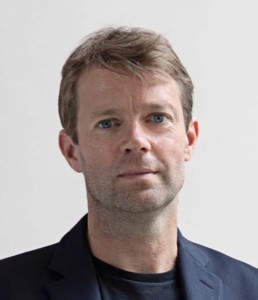
Bas Smets received a MArch and Civil Engineering degree from the University of Leuven and a MLA from the University of Geneva. Since founding his Brussels-based firm, Bureau Bas Smets, in 2007, he has completed more than 50 projects in more than 12 countries with his team of 25 architects and landscape architects. Smets builds his project teams with artists, philosophers, soils and hydrology experts, ecologists, and climate scientists. His collaborative research and evidence-based model of practice reflects an openness to experimentation and invention. In 2008 he was awarded the biennial French Prize for Young Architects and Landscape Designers, and in 2018 he was awarded the Medal for Urbanism and Public Space from the French Royal Academy of Architecture. Bureau Bas Smets more recently won perhaps the most coveted commission in all of Europe: the reimagining of the public space around the Notre-Dame in Paris, commensurate with the restoration and renewal of the fire-damaged Cathedral. The winning scheme in the two-stage competition adapts the urban microclimate of the Ile de la Cité and cathedral grounds—a primary preoccupation for Smets in all of his work. Smets’ realized projects include the park of Thurn & Taxis and the Saint-Gilles Plaza in Brussels; the public space around the Trinity Tower in Paris La Défense; the Sunken Garden and the Mandrake Hotel in London; the Himara Waterfront in Albania; and recently the Parc des Ateliers in Arles, France, a collaboration with the US practices of Annabelle Selldorf and Frank Gehry. A number of large projects are under construction, such as the urban forest around the Part Dieu station in Lyon, the Nieuw Zuid project in Antwerp, and an art park in Amagansett, New York. In each of these projects, the aim is to invent “augmented landscapes” by using the logics of nature. These augmented landscapes produce favorable adjustments to microclimates while also exploring changed atmospheres and perceptions of space.
Dan Stubbergaard appointed Professor in Practice of Urban Design
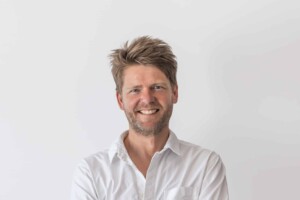
Dan Stubbergaard trained as an architect at the Royal Danish Academy of Fine Arts, School of Architecture, in Copenhagen. He founded the firm Cobe in 2006. Inspired by the transformation of Copenhagen from an industrial port city to a beacon for livability and sustainability, he is the leading figure in Cobe’s work to create cities, buildings, and landscapes that are made to outlast our generation and contribute to extraordinary everyday life. His research focuses on investigating solutions, tools, and methodologies across several topics or themes of interest including resilient urban development, green mobility, transformation and reuse, new ways of building, social responsibility, urban nature, and longevity. Having received national and international acclaim for his work, including the C.F. Hansen Royal Medal from the Danish Academy Council in 2020, the Nykredit Architecture Award in 2012, and the Golden Lion at the Venice Biennale in 2006, he has designed and completed award-winning projects globally. Exemplary of his work are the long-term Nordhavn project in Copenhagen, begun in 2008, which converted a former shipyard into an urban district with pedestrian and bike-friendly infrastructure, and the Paper Island project (2016–2023), which converted a former industrial site into a vibrant inner-city neighborhood with different building scales and public spaces. His approach to teaching is based on synthesizing various fields of knowledge, linking urban planning, architecture, and landscape architecture to understand the dynamics of cities, and creating a clear set of values and priorities for the future evolution of our cities and landscapes. This approach reflects a belief that learning from practice, resilient buildings, urban areas, and landscapes must be tailored to a specific context, as well as to the current and future users of that place.
Jeffry Burchard (MArch ’08) promoted to Associate Professor in Practice of Architecture

Jeffry Burchard is Managing Partner & Principal at Machado Silvetti and has taught continuously at the GSD for twelve years. After serving as a Design Critic in Architecture from 2012-2017, Burchard was appointed as Assistant Professor in Practice of Architecture following a search in 2017. Following a B.A. and MArch from the University of Idaho College of Art and Architecture, Burchard enrolled in our own MArch II program, which he graduated from with distinction in 2008. Upon graduation from the GSD, Burchard began work in the office of Machado Silvetti, first as a Senior Designer, and was named Partner & Principal in 2015. At the GSD, Burchard has offered instruction in Core Design Studios, thesis and professional practice and is the school’s representative to the Boston Society for Architecture (BSA). At the BSA Jeffry co-created and hosted the Now-Practice-Now workshop series and he created and hosted the Opening Soon online lecture series. Jeffry received the 2020 AIA Young Architects Award for his demonstrated commitment to excellence in design, professional practice, and education. He regularly reviews student work around the world, and he has served on several professional juries including the AIA San Francisco and AIA Montana Design Awards and the Liberty Museum ideas competition. Burchard’s work and writings have been featured in publications such as commonedge, CLOG, IntAR, Competition, Architect, Architecture Record, Domez, Clarin, and the Architect’s Newspaper.
Danielle Choi (MLA ’08) promoted to Associate Professor of Landscape Architecture
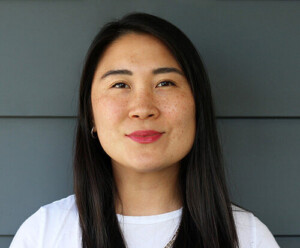
Danielle Choi joined the GSD as a Daniel Urban Kiley teaching fellow in 2016 and subsequently as Assistant Professor. Choi has taught and coordinated core landscape architecture studios, led design research seminars, advised design thesis students, and has had an effective voice in the department’s curricular development and focus on student well-being and belonging. Prior to joining the GSD, Choi practiced as a landscape architect for nearly a decade in the United States and Europe, and her teaching has deep roots in practice and is enriched by a continued commitment to the influence of practice on design pedagogy. Choi’s writing on the cultural practices of landscape infrastructure and technology has been published in the Journal of Architectural Education, Harvard Design Magazine, Studies in the History of Gardens & Designed Landscapes, and Landscape Architecture. Choi has also taught studio in urban design at Columbia University. She is a licensed landscape architect and has practiced with Topotek in Berlin and Michael Van Valkenburgh Associates (MVVA) in New York. As a senior associate at MVVA, she led strategy and design of complex urban landscapes and managed large, multi-disciplinary teams. Choi holds a degree in art history from the University of Chicago and a Master in Landscape Architecture from the GSD, receiving the Jacob Weidenmann award for excellence in design.

